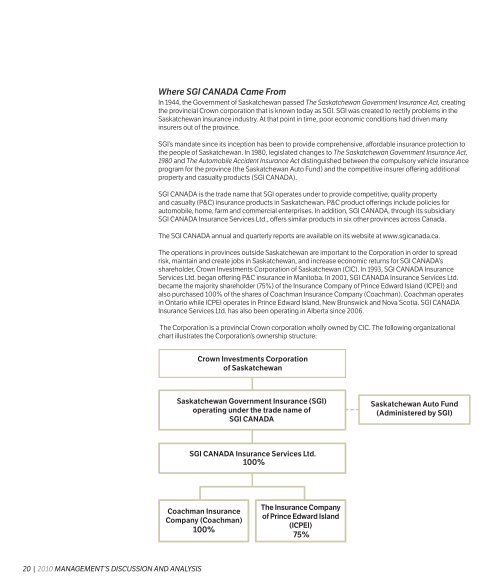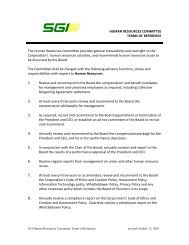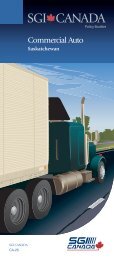Full report - SGI Canada
Full report - SGI Canada
Full report - SGI Canada
You also want an ePaper? Increase the reach of your titles
YUMPU automatically turns print PDFs into web optimized ePapers that Google loves.
Consolidated Statement of Comprehensive Income<br />
2010 2009 Change<br />
(thousands of $)<br />
Net income $ 48,356 $ 52,367 $ (4,011)<br />
Other comprehensive<br />
income 7,169 30,151 (22,982)<br />
Total comprehensive<br />
income $ 55,525 $ 82,518 $ (26,993)<br />
Comprehensive income is the sum of net income and other items that must bypass the statement<br />
of operations because they have not been realized (other comprehensive income or loss). For the<br />
Corporation, this includes unrealized gains and losses from available for sale investments. These<br />
unrealized gains and losses are not part of net income, yet are important enough to be included in<br />
comprehensive income, giving the user a more comprehensive picture of the organization as a whole.<br />
In 2010, other comprehensive income added $7.2 million to net income for total comprehensive income of<br />
$55.5 million. Other comprehensive income decreased $23.0 million compared to 2009. This decrease is a<br />
result of the lower market rate of return in 2010 compared to 2009, in addition to realizing significant gains<br />
in 2010 compared to 2009.<br />
Consolidated Statement of Cash Flows<br />
2010 2009 Change<br />
(thousands of $)<br />
Operating activities $ 52,668 $ 68,432 $ (15,764)<br />
Investing activities 8,478 (44,564) 53,042<br />
Financing activities (50,257) (19,247) (31,010)<br />
Change in cash and<br />
cash equivalents $ 10,889 $ 4,621 $ 6,268<br />
Operating activities<br />
Cash from operations contributed $52.7 million in 2010 compared to $68.4 million in 2009. While net<br />
income year-over-year is relatively similar, the lower underwriting profit in the current year is responsible<br />
for the decline. The significant storm claims impacted cash flows in 2010 compared to 2009, which had<br />
minimal storm activity. However, at $52.7 million, 2010 cash flow from operations is still strong, primarily<br />
due to the continued favourable premium growth from all companies.<br />
Investing activities<br />
Each legal entity’s excess cash from operating activities is invested in its own investment portfolio The<br />
investment manager actively trades each investment portfolio in the capital markets following the<br />
conditions set out in each legal entity’s Statement of Investment Policies and Goals. For 2010, the<br />
investment manager, on a consolidated basis, generated cash through proceeds from the sale of<br />
investments of $543.1 million (2009 – $419.9 million), and reinvested into investments $531.7 million (2009 –<br />
$464.9 million). In addition, there were $3.4 million in purchases of property, plant and equipment in 2010,<br />
resulting in a net generation of cash during the year of $8.5 million (2009 – net use of cash of $44.6 million).<br />
Financing activities<br />
Financing activities during the year related solely to dividends paid during the year of $50.3 million<br />
(2009 – $19.2 million). Dividends paid during 2010 were significantly higher than in 2009 due to the<br />
dividend rate increasing from 65% in 2009 to 90% in 2010. In addition, the 2009 fourth quarter dividend<br />
payment (paid in March 2010) was unusually high at $22.2 million.<br />
Cash and cash equivalents<br />
Of the $61.1 million of cash generated from operations and investing activities, $50.3 million was used to<br />
pay dividends and the remaining $10.9 million was added to cash and cash equivalents. Cash and cash<br />
equivalents was $27.8 million at the end of 2010. Of this balance, $26.4 million is invested in money market<br />
investments with a maturity of 90 days or less from the date of acquisition.<br />
Consolidated Statement of Financial Position<br />
2010 2009 Change<br />
(thousands of $)<br />
Total assets $ 872,815 $ 827,437 $ 45,378<br />
Key asset account changes:<br />
Unpaid claims recoverable<br />
from reinsurers 44,132 29,626 14,506<br />
Investments 591,219 579,730 11,489<br />
Cash and cash equivalents 27,809 16,920 10,889<br />
Deferred policy acquisition costs 56,204 52,412 3,792<br />
Accounts receivable 127,479 125,334 2,145<br />
Unpaid claims recoverable from reinsurers<br />
Unpaid claims recoverable from reinsurers increased $14.5 million in 2010, primarily due to amounts<br />
related to the unusually severe storm activity in Saskatchewan. Amounts due under Saskatchewan 2010<br />
storm catastrophe reinsurance agreements account for $18.8 million of the recoverable balance.<br />
Investments<br />
The carrying value of investments increased by $11.5 million during the year, primarily the result of a<br />
$25.2 million improvement in market values, offset by a net $11.3 million moved from investments into cash.<br />
The Corporation’s investment strategy is based on prudence, regulatory guidelines and claim settlement<br />
patterns, with a view to maximizing long-term returns utilizing a conservative investment portfolio. The<br />
portfolio’s asset mix strategy is set by the Board through a detailed assessment of the Corporation’s risk<br />
tolerance. The asset mix strategy takes into consideration the current and expected conditions of the<br />
capital markets, and the historic return and risk profile of various asset classes. In order to achieve the<br />
long-term investment goals, the portfolio must invest in asset classes that provide an attractive risk-return<br />
profile over the medium to long-term. Over shorter periods, however, performance of these asset classes<br />
can be volatile. In 2010, volatility continued, although at a lower rate, with positive gains building on the<br />
strong reversal that was experienced in 2009. The Corporation believes a diversified asset mix and longerterm<br />
focus remains appropriate, balancing the need for capital preservation in the short term with the<br />
desire for portfolio growth over the longer term.<br />
40 | 2010 MANAGEMENT’S DISCUSSION AND ANALYSIS MANAGEMENT’S DISCUSSION AND ANALYSIS 2010 | 41















